“Erected by citizens of Bristol as a memorial of one of the most virtuous and wise sons of their city, AD 1895”, said a dark plaque decorating an empty plinth in the centre of Bristol, the largest city in south-west England. That “most virtuous and wise son” was Edward Colston, a 17th-Century merchant who oversaw the enslavement of 84,000 Africans, 19,000 of whom are thought to have died en route to the Americas.
Colston’s role in the slave trade was ignored by the Victorians, who revered his philanthropic work – Colston used his profits to found schools, churches and almshouses in his native Bristol – and erected a statue of him nearly two centuries after his death in 1721. But on 7 June 2020, the statue was torn down, daubed in red paint and blue graffiti and thrown into the harbour during an anti-racism protest that made worldwide headlines .
It was a divisive moment, but one that spoke of an increasing desire in Bristol to confront a darker past in a city that’s known for its liberal and often rebellious outlook. Now, as Bristol re-evaluates its history, visitors can gain a diverse view of the city through tours that delve into the transatlantic slave trade and walks dedicated to Bristol’s modern multicultural communities.
“As a tour guide, I always talked about everything great in Bristol,” said Rob Collin, who developed the Bristol Slave Trade Walk to explore a history he never learned in school. “The more I read, the more I began to ask: how can we talk about Bristol without talking about the slave trade?”
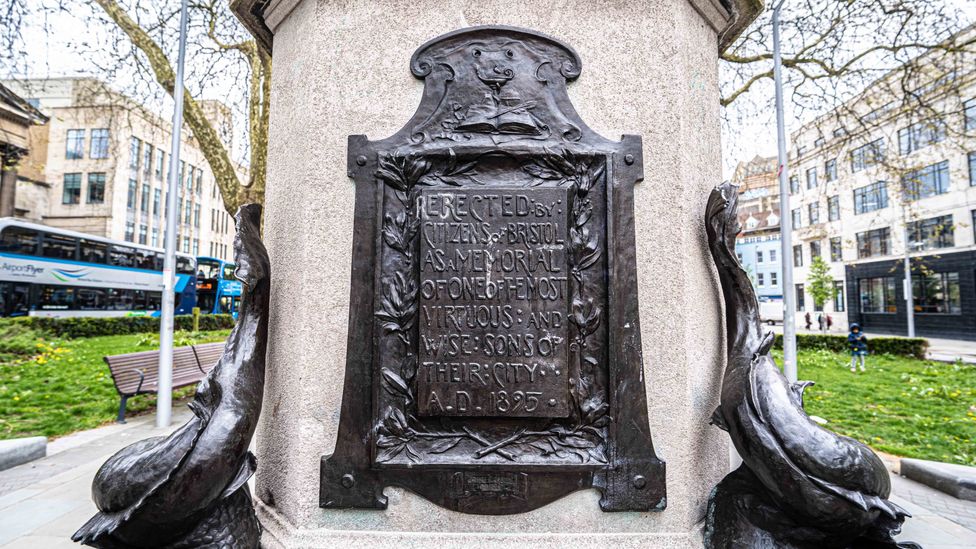
Edward Colston’s statue was torn down in 2020 during an anti-racism protest, leaving an empty plinth (Credit: Richard Collett)
As we stood in Queen Square, where a grand equestrian statue of King William III is surrounded by elegant Georgian architecture, Collin explained how Bristol’s location on the River Avon, close to the Bristol Channel, enabled the city to become heavily involved in the transatlantic slave trade in the 17th Century. Few slaves ever set foot in Bristol itself, but the city benefited from a triangular trade that shipped goods from Europe to Africa, sent enslaved Africans to colonies in the Americas and brought commodities like tobacco, sugar and cocoa back to Europe. Collin noted that Bristol ships trafficked an estimated 486,000 enslaved Africans between 1698 and the abolition of the slave trade in 1807, making Bristol the third-largest slave trading port in England after Liverpool and London.
“Bristol was transformed in the 17th and 18th Centuries,” he said, as we walked past grand merchant houses in Queen’s Square that all date from 1699 onwards. “And that’s no coincidence. It was transformed because of the transatlantic slave trade.”
Central to that transformation was Colston. Born in Bristol in 1636, he rose through the ranks of the Royal African Company, which was founded in 1660 as a joint venture by merchants in the City of London and the ruling Stuart family that sat on the thrones of both England and Scotland. Colston was on the board of the Royal African Company between 1680 and 1692, becoming deputy governor in 1689 when the company had a monopoly on the slave markets in West Africa.
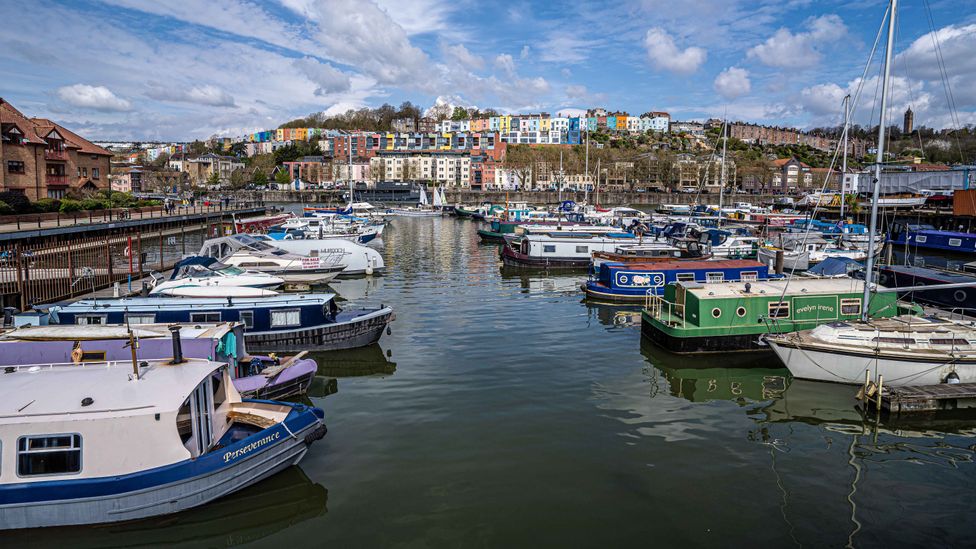
Bristol was once the third-largest slave trading port in England after Liverpool and London (Credit: Richard Collett)
While an estimated 84,000 Africans were transported in deadly conditions on Royal African Company ships (19,000 never made it) to work on sugar plantations and tobacco farms in the Americas, Colston used his wealth to found Bristol’s Collegiate School (formerly known as Colston’s School ) and Colston’s Almshouses (which provided charitable accommodation for the poor), while providing funding for Queen Elizabeth Hospital .
Whether you view him as good or bad, we can say without a doubt that Edward Colston had blood on his hands
“He was number two in the Royal African Company, and therefore number two in the entire English slave trade,” said Collin as he guided me to Colston’s now-empty plinth. “That’s why this is so important. Whether you view him as good or bad, we can say without a doubt that Edward Colston had blood on his hands.”
From 1698 onwards – when the Royal African Company’s monopoly was broken – many of Bristol’s wealthiest families also made their fortunes directly off the slave trade or through the slave economy associated with sugar, tobacco and cocoa. Following the Slavery Abolition Act of 1833 , when slave owners were compensated with vast sums of money by the British government ( a debt so large that British taxpayers only finished paying it off in 2015 ), even more cash was available to invest in the city, the legacy of which is still very much visible today.
Collin showed me the Wills Memorial Building, a great Gothic work of architecture built to memorialise the Wills family, merchants who profited from slave-grown tobacco and gave large chunks of their wealth to the University of Bristol. Another of the city’s famous sons is Joseph Storrs Fry, who imported slave-grown cocoa to Bristol, commercialised chocolate-eating in England and founded a company that eventually merged with Cadburys.
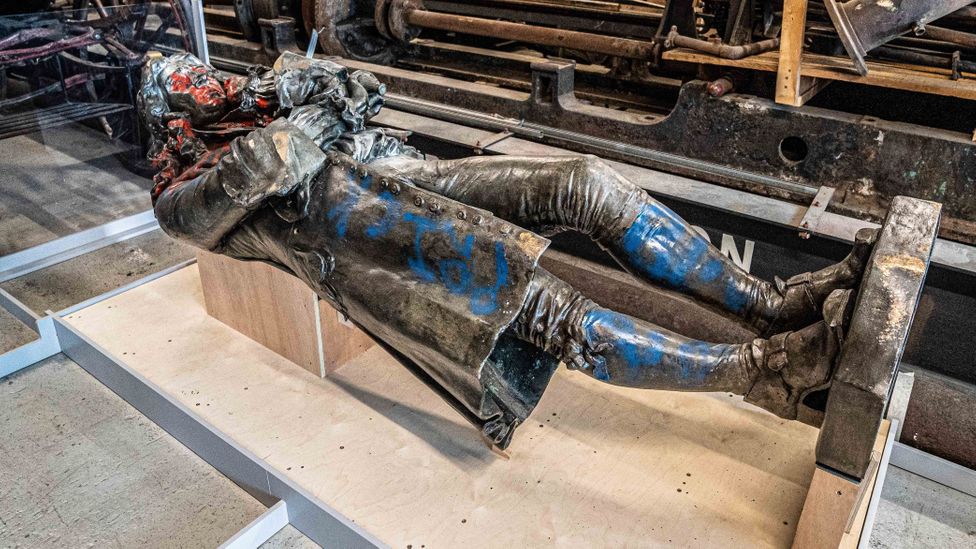
The graffitied statue of the slave trader and philanthropist is now on display at M-Shed (Credit: Richard Collett)
“Thousands died on the ships, generations of people went into slavery, and at the time, it was somehow socially acceptable,” said Martin Wilson, who leads b ehind-the-scenes tours of M Shed, a museum overlooking Bristol harbour where visitors can see the now-preserved remains of Colston’s statue. “The Victorians put the statue up almost 200 years after he died, but it had very little to do with the real Colston. They just swept the slavery thing under the carpet and said: ‘Look at all the good he did’.”
The dark side of the story didn’t fit with the philanthropic narrative the Victorians wanted to promote in a 19th-Century Bristol that held an annual “Colston Day” celebration. But following increased immigration to the United Kingdom after World War Two, the city began to question not only its past but how it treated its increasingly diverse communities in the present.
Since the 1950s, Bristol’s Afro-Caribbean community has traditionally been centred around the suburb of St Pauls, where visitors can explore the different sites associated with the city’s Black history on a self-guided walking tour designed by Tanja Aminata Bah when she was studying for a Masters in Curating at the University of the West of England in Bristol.
I walked past colourful murals dedicated to the ” Seven Saints of St Pauls ” that depicts seven local Black activists – including Audley Evans, Barbara Dettering and Roy Hackett – who were involved in the Bristol Bus Boycotts of 1963 that protested discriminatory and racist hiring practices in Bristol and directly led to the passing of the Race Relations Act 1965 in the United Kingdom . I was struck by how little I knew of the recent history of a city I’d lived in throughout the Covid-19 lockdown.
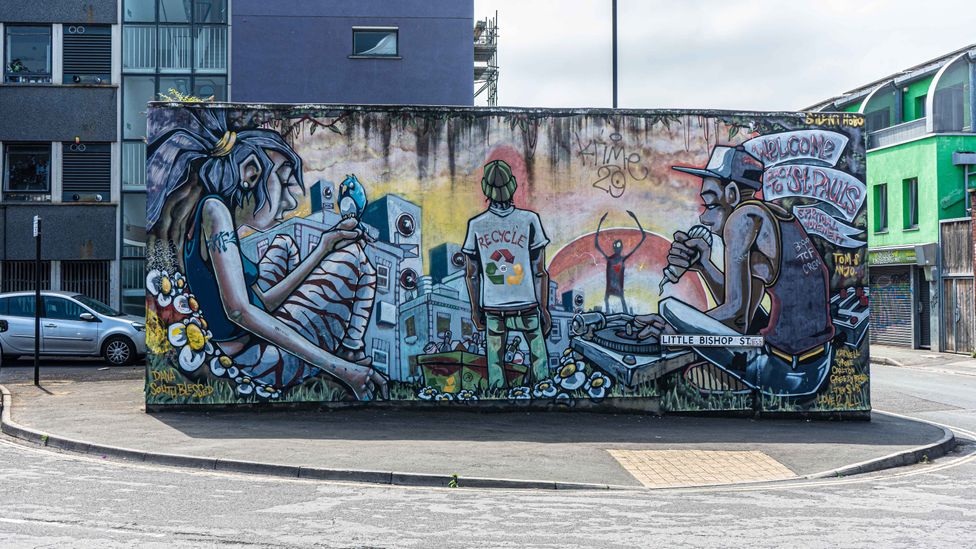
Visitors can explore Bristol’s Black history on a walking tour around St Pauls (Credit: Richard Collett)
“People do not know enough about their history,” said Bah, who mapped out the Black history of St Pauls in 2017. “Especially not about the more diverse history there is in cities like Bristol. Helping people understand this diverse history is a starting point for changing perspectives.”
Bah’s project came at a time when many Bristolians were asking which historical characters should be memorialised. “When you have a street named after you, it’s an honour,” said Bah. “But even if you’re the biggest charity giver in the city, you should not have that honour if you have shipped people off to slavery.”
Look out from the top-floor viewing area at M Shed, and you can see Pero’s Bridge. Opened in 1999, it was named not for a wealthy Bristolian merchant, but for Pero Jones, an enslaved African brought to Bristol in 1783. In 2017, the Colston Hall music venue decided to rebrand as “Bristol Beacon”, and in 2018, Bristol City Council agreed to add a second plaque to the now infamous statue explaining Colston’s role in the slave trade, although this never materialised.
I think Bristol is unlike any other city in the UK. There’s a strong, rebellious, independent spirit that manages to be both collaborative and innovative
“I think Bristol is unlike any other city in the UK,” said Kathryn Davis, the managing director of Visit West, the tourism board overseeing Bristol. “There’s a strong, rebellious, independent spirit that manages to be both collaborative and innovative.”
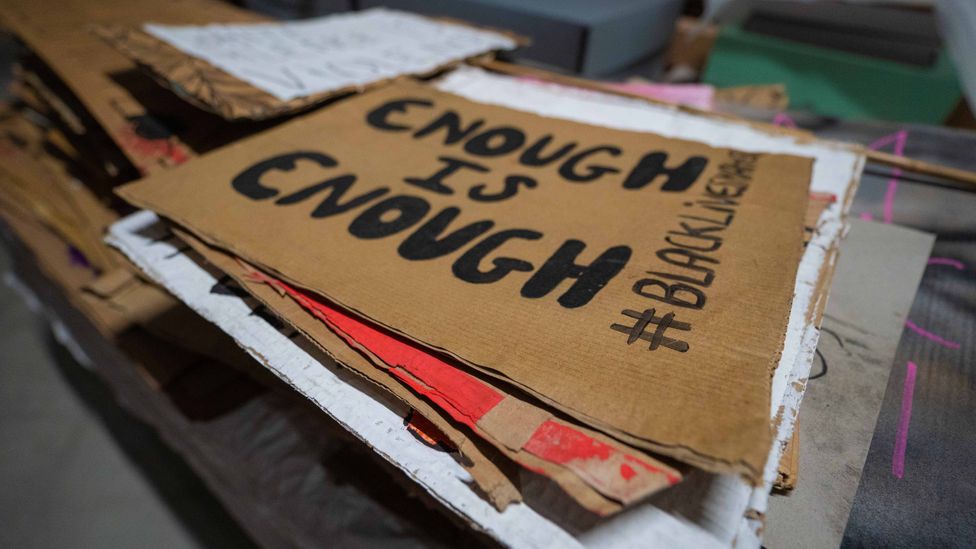
M-Shed is also home to placards and other artefacts from the protest that toppled Colston’s statue (Credit: Richard Collett)
This rebellious streak was cemented by the toppling of Colston’s statue at the height of Black Lives Matter protests in 2020, a moment that led many institutions and businesses to sever their associations with Colston’s name. With M-Shed also hosting a permanent exhibition that explores the city’s role in the transatlantic slave trade, Bristol’s past is becoming more transparent.
Inevitably, though, the toppling of statues and renaming of Bristol institutions came up against fierce opposition. Conservative politicians like the Home Secretary Priti Patel described the changes in Bristol as “utterly disgraceful”, while many right-wing news outlets alleged that Colston was being erased from Bristol’s history or said that we shouldn ‘ t judge historical characters on modern morals .
“When the music hall was renamed and when the statue was pulled down, it did more to confront this subject than ever before,” said Collin, who believes it’s a disservice to the abolitionists of the day to say that British society didn’t know the slave trade was immoral. “Far from erasing history, it’s done the exact opposite,” he added. “It was the Victorians who erased history, and the lives of the enslaved Africans who were erased.”
The bare plinth speaks louder than Colston’s statue ever did, but Wilson explained how M-Shed met differing views when deciding what to do with the fallen effigy of the slave trader and philanthropist. Should it be left in the harbour, re-raised or placed in a museum, they asked the Bristolian public.
“It was eventually decided that the statue would be kept in this condition, with the graffiti preserved, so we have its historical context. It only happened two years ago, but it’s already part of our history,” said Wilson, as I took one last look at Colston’s graffitied statue in M-Shed. “Honestly, it’s the most interesting thing that’s ever happened to this statue.”
—
Join more than three million BBC Travel fans by liking us on Facebook , or follow us on Twitter and Instagram .
If you liked this story, sign up for the weekly bbc.com features newsletter called “The Essential List”. A handpicked selection of stories from BBC Future, Culture, Worklife and Travel, delivered to your inbox every Friday.

